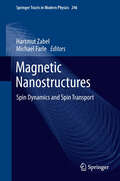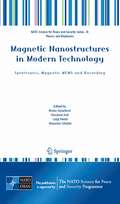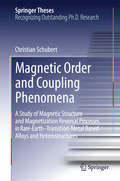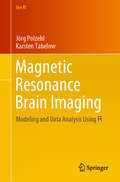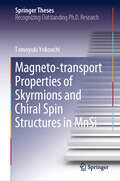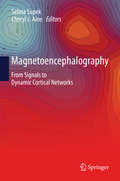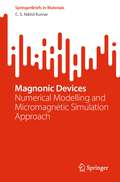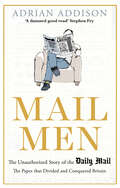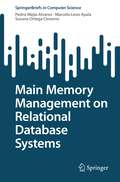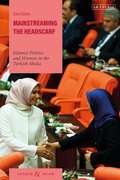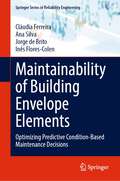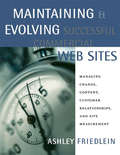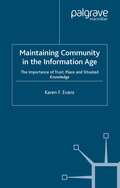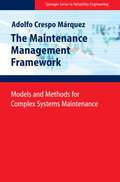- Table View
- List View
Magnetic Nanostructures: Spin Dynamics and Spin Transport (Springer Tracts in Modern Physics #246)
by Hartmut Zabel Michael FarleNanomagnetism and spintronics is a rapidly expanding and increasingly important field of research with many applications already on the market and many more to be expected in the near future. This field started in the mid-1980s with the discovery of the GMR effect, recently awarded with the Nobel prize to Albert Fert and Peter Grünberg. The present volume covers the most important and most timely aspects of magnetic heterostructures, including spin torque effects, spin injection, spin transport, spin fluctuations, proximity effects, and electrical control of spin valves. The chapters are written by internationally recognized experts in their respective fields and provide an overview of the latest status.
Magnetic Nanostructures in Modern Technology: Spintronics, Magnetic MEMS and Recording (NATO Science for Peace and Security Series B: Physics and Biophysics)
by Bruno Azzerboni Giovanni Asti Luigi Pareti Massimo GhidiniIn this book, a team of outstanding scientists in the field of modern magnetic nanotechnologies illustrates the state-of-the-art in several areas of advanced magneto-electronic devices, magnetic micro-electromechanical systems and high density information storage technologies. Providing a unique source of information for the young physicist, chemist or engineer, the book also serves as a crucial reference for the expert scientist and the teacher of advanced university courses.
Magnetic Order and Coupling Phenomena: A Study of Magnetic Structure and Magnetization Reversal Processes in Rare-Earth-Transition-Metal Based Alloys and Heterostructures (Springer Theses)
by Christian SchubertThis thesis presents recent developments in magnetic coupling phenomena of ferrimagnetic rare-earth transition-metal Tb-Fe alloys and coupled systems consisting of ferri-/ferromagnetic heterostructures. Taking advantage of the tunability of the exchange coupling between ferrimagnetic and ferromagnetic layers by means of stoichiometry of the Tb-Fe layer, the variable number of repetitions in the Co/Pt multilayer as well as the thickness of an interlayer spacer, it is demonstrated that large perpendicular unidirectional anisotropy can be induced at room temperature. This robust perpendicular exchange bias at room temperature opens up a path towards applications in spintronics.
Magnetic Resonance Brain Imaging: Modeling and Data Analysis Using R (Use R!)
by Jörg Polzehl Karsten TabelowThis book discusses the modeling and analysis of magnetic resonance imaging (MRI) data acquired from the human brain. The data processing pipelines described rely on R. The book is intended for readers from two communities: Statisticians who are interested in neuroimaging and looking for an introduction to the acquired data and typical scientific problems in the field; and neuroimaging students wanting to learn about the statistical modeling and analysis of MRI data. Offering a practical introduction to the field, the book focuses on those problems in data analysis for which implementations within R are available. It also includes fully worked examples and as such serves as a tutorial on MRI analysis with R, from which the readers can derive their own data processing scripts. The book starts with a short introduction to MRI and then examines the process of reading and writing common neuroimaging data formats to and from the R session. The main chapters cover three common MR imaging modalities and their data modeling and analysis problems: functional MRI, diffusion MRI, and Multi-Parameter Mapping. The book concludes with extended appendices providing details of the non-parametric statistics used and the resources for R and MRI data.The book also addresses the issues of reproducibility and topics like data organization and description, as well as open data and open science. It relies solely on a dynamic report generation with knitr and uses neuroimaging data publicly available in data repositories. The PDF was created executing the R code in the chunks and then running LaTeX, which means that almost all figures, numbers, and results were generated while producing the PDF from the sources.
Magnetic Resonance Brain Imaging: Modelling and Data Analysis Using R (Use R!)
by Jörg Polzehl Karsten TabelowThis book discusses modelling and analysis of Magnetic Resonance Imaging (MRI) data of the human brain. For the data processing pipelines we rely on R, the software environment for statistical computing and graphics. The book is intended for readers from two communities: Statisticians, who are interested in neuroimaging and look for an introduction to the acquired data and typical scientific problems in the field and neuroimaging students, who want to learn about the statistical modeling and analysis of MRI data. Being a practical introduction, the book focuses on those problems in data analysis for which implementations within R are available. By providing full worked-out examples the book thus serves as a tutorial for MRI analysis with R, from which the reader can derive its own data processing scripts.The book starts with a short introduction into MRI. The next chapter considers the process of reading and writing common neuroimaging data formats to and from the R session. The main chapters then cover four common MR imaging modalities and their data modeling and analysis problems: functional MRI, diffusion MRI, Multi-Parameter Mapping and Inversion Recovery MRI. The book concludes with extended Appendices on details of the utilize non-parametric statistics and on resources for R and MRI data.The book also addresses the issues of reproducibility and topics like data organization and description, open data and open science. It completely relies on a dynamic report generation with knitr: The books R-code and intermediate results are available for reproducibility of the examples.
Magnetic Straintronics: An Energy-Efficient Hardware Paradigm for Digital and Analog Information Processing (Synthesis Lectures on Engineering, Science, and Technology)
by Supriyo BandyopadhyayThis book covers the new field of straintronics, using strain switched nanomagnets for extremely energy-efficient computing, information processing, communication, and signal generation. Based on well-established CMOS technology, traditional electronics have two significant shortcomings: excessive energy dissipation and volatility, which is the inability to retain information after power has been switched off. Straintronics is more energy-efficient and non-volatile (but also more error-prone), allowing it to eclipse traditional electronics in niche areas that are increasingly attracting attention, such as image processing and probabilistic computing, computer vision, machine learning, neuromorphic networks, probabilistic computing, and belief networks. Magnetic Straintronics: An Energy-Efficient Hardware Paradigm for Digital and Analog Information Processing introduces straintronics and the technology's myriad applications for researchers, engineers, and scientists in electrical engineering, physics, and computer engineering.
Magneto-transport Properties of Skyrmions and Chiral Spin Structures in MnSi (Springer Theses)
by Tomoyuki YokouchiThis book provides extensive and novel insights into transport phenomena in MnSi, paving the way for applying the topology and chirality of spin textures to the development of spintronics devices. In particular, it describes in detail the key measurements, e.g. magnetoresistance and nonlinear electronic transport, and multiple material-fabrication techniques based on molecular beam epitaxy, ion-beam microfabrication and micromagnetic simulation. The book also reviews key aspects of B20-type MnSi chiral magnets, which host magnetic skyrmions, nanoscale objects formed by helical spatial spin structures. Readers are then introduced to cutting-edge findings on the material. Furthermore, by reviewing the author’s successful experiments, the book provides readers with a valuable update on the latest achievements in the measurement and fabrication of magnetic materials in spintronics.
Magnetoencephalography: From Signals to Dynamic Cortical Networks (Series In Bioengineering Ser.)
by Selma Supek Cheryl J. AineMagnetoencephalography (MEG) is an invaluable functional brain imaging technique that provides direct, real-time monitoring of neuronal activity necessary for gaining insight into dynamic cortical networks. Our intentions with this book are to cover the richness and transdisciplinary nature of the MEG field, make it more accessible to newcomers and experienced researchers and to stimulate growth in the MEG area. The book presents a comprehensive overview of MEG basics and the latest developments in methodological, empirical and clinical research, directed toward master and doctoral students, as well as researchers. There are three levels of contributions: 1) tutorials on instrumentation, measurements, modeling, and experimental design; 2) topical reviews providing extensive coverage of relevant research topics; and 3) short contributions on open, challenging issues, future developments and novel applications. The topics range from neuromagnetic measurements, signal processing and source localization techniques to dynamic functional networks underlying perception and cognition in both health and disease. Topical reviews cover, among others: development on SQUID-based and novel sensors, multi-modal integration (low field MRI and MEG; EEG and fMRI), Bayesian approaches to multi-modal integration, direct neuronal imaging, novel noise reduction methods, source-space functional analysis, decoding of brain states, dynamic brain connectivity, sensory-motor integration, MEG studies on perception and cognition, thalamocortical oscillations, fetal and neonatal MEG, pediatric MEG studies, cognitive development, clinical applications of MEG in epilepsy, pre-surgical mapping, stroke, schizophrenia, stuttering, traumatic brain injury, post-traumatic stress disorder, depression, autism, aging and neurodegeneration, MEG applications in cognitive neuropharmacology and an overview of the major open-source analysis tools.
Magnetohydrodynamic Modeling of the Solar Corona and Heliosphere (Atmosphere, Earth, Ocean & Space)
by Xueshang FengThe book covers intimately all the topics necessary for the development of a robust magnetohydrodynamic (MHD) code within the framework of the cell-centered finite volume method (FVM) and its applications in space weather study. First, it presents a brief review of existing MHD models in studying solar corona and the heliosphere. Then it introduces the cell-centered FVM in three-dimensional computational domain. Finally, the book presents some applications of FVM to the MHD codes on spherical coordinates in various research fields of space weather, focusing on the development of the 3D Solar-InterPlanetary space-time Conservation Element and Solution Element (SIP-CESE) MHD model and its applications to space weather studies in various aspects. The book is written for senior undergraduates, graduate students, lecturers, engineers and researchers in solar-terrestrial physics, space weather theory, modeling, and prediction, computational fluid dynamics, and MHD simulations. It helps readers to fully understand and implement a robust and versatile MHD code based on the cell-centered FVM.
Magnonic Devices: Numerical Modelling and Micromagnetic Simulation Approach (SpringerBriefs in Materials)
by C. S. Nikhil KumarThis book briefly looks at numerical modeling and micromagnetic simulation results of magnonic crystals, which are periodically modulated magnonic devices regarded as the magnetic counterpart of photonic crystals with spin waves acting as the information carrier. Since the wavelength of the spin wave is several orders of magnitude shorter than that of electromagnetic waves of the same frequency, magnonic crystals are promising candidates for miniaturization, especially in the fields of data storage and processing. The book begins by describing the dispersion relation of dipolar spin waves in a magnonic curved waveguide, solving Walker's equation in cylindrical coordinates, and then calculating the dispersion of exchange spin waves using perturbation theory. It describes simulated nano-contact-driven spin wave excitations in a magnonic cavity, featuring a design of an antidot magnonic crystal around the nano-contact, with the frequency of the spin wave mode generated lying within the band gap of the magnonic crystal. The proposed device behaves as a SWASER—Spin Wave Amplification by the Stimulated Emission of Radiation. This book will find interest among researchers and practitioners interested in the modeling, simulation, and design of novel magnonic devices.
Mahara 1.2 ePortfolios Beginner's Guide: Create And Host Educational And Professional E-portfolios And Personalized Learning Communities - Beginner's Guide
by Derrin Michael Kent Glenys Gillian Bradbury Margaret Anne Kent Richard William HandIn DetailMahara is a user-centred environment with a permissions framework that enables different views of an e-portfolio to be easily managed. These views helps you display your artefacts - text files, spreadsheets, images, and videos - in a way you choose and to the people you want. You can also create online communities and social networks through groups, blogs, and forums.Being a novice, you will need a quick and easy implementation guide to set up your feature-rich digital portfolio.This book is your step-by-step guide to building an impressive professional e-portfolio using Mahara. It covers the key features of Mahara that will help you set up your customized digital portfolio and display the artefacts in your preferred way allowing contribution from selected users only.This book will introduce to the exciting features of Mahara framework and help you develop a feature-rich e-portfolio for yourself. You will see how easily you can create folders, upload multiple files like journals, project documents, pictures, and videos and share them with your friends. You will learn to set up views of these files, making these visible to your chosen friends only. And then, you will allow people to give their inputs.You will learn to create blogs and forums and get connected to the rest of the world. Customization and administration of your Mahara site will become easy after you have gone through this book. Imagine how good you will feel when you will see your knowledge, success, and ideas going live and available to your chosen audiences for their inputs.Develop a feature-rich electronic portfolio - a digital repository of journals, presentations, reports, images, and videos - easily and share it with your friends, family, students, project team, and othersApproachThis book will provide you with step-by-step instructions to get started with Mahara and create an impressive electronic portfolio. The book is packed with many useful examples and screenshots for easy and quick learning.Who this book is forPick this book up if you want to get started with Mahara.This book is for you if:You are a student/learner wanting to maintain online documentation of your projects and share it with a particular teacher/trainer for feedbackYou are a teacher wanting to set up an e-portfolio for your students in order to encourage and advance personalized and reflective learningYou are a professional wanting to share your journals and project documents with your team by sharing your existing knowledge and creating new knowledge in communities of professional practiceNo previous experience of Mahara is required.
Mahara 1.4 Cookbook
by Ellen Marie MurphyPart of Packt's cookbook series, this book offers learning and techniques through recipes. It contains step-by-step instructions for Mahara users of all kinds. It is designed in such a way that you can refer to recipes chapter by chapter, or read them in no particular order. Whether you are a student, an instructor, an administrator, or simply someone who would like to build your own portfolio, this book is for you. The range of recipes is wide, because Mahara's features can support portfolio development and use, regardless of level or purpose. This book requires only a very basic knowledge of Mahara.
Mahara ePortfolios Beginner's Guide: Beginner's Guide
by Derrin Kent Richard Hand Thomas W. BellIn Detail Mahara ePortfolios helps you to use software as you follow an experiential learning cycle. In Mahara you can: Plan your learning. Do what you do and gather evidence of your competence as you do those things. View and organize your work by structuring your data in easy-to-make (web)pages and (mini-website) collections of those pages. Reflect on your learning by use of professional journals, engaging feedback on your pages and establishing and engaging in online communities who share a similar interest. Mahara ePortfolios: Beginner's Guide is a step-by-step guide to develop a feature-rich and highly personal electronic portfolio. Form a digital repository of reflective journals, action learning plans, presentations, reports, images and videos. Easily share this with your friends, family, tutors, students, project team and others using this step-by-step guide written in a clear and easy to learn manner. This book guides you to build an impressive e-Portfolio and to work in professional communities of interest within a Mahara walled garden. It brings to life the key features of Mahara which will help thoughtful people to display their artefacts coherently and to engage with like-minded peers professionally. This book introduces you to exciting features of Mahara framework and helps you develop a feature-rich e-portfolio for yourself. You will see how easily you can create folders, upload multiple files like project documents, pictures and videos and share them with your friends. You will learn to set up single pages and collections of pages which organize these files, making these visible only to your own chosen peers, supervisors or friends. Then, you will allow people to give their inputs. You will learn to create journals, learning plans, your professional resume, group spaces and forums which help you get connected to the rest of the world. Customization and administration of your Mahara site will be easy after you have gone through this book. Imagine how good you will feel when you will see your knowledge, success, and ideas going live and available to your chosen audiences for their inputs. Mahara ePortfolios: Beginner's Guide is a step-by-step guide to building an impressive professional e-portfolio using Mahara. It covers the key features of Mahara that will help you set up your customized digital portfolio and display the artefacts in your preferred way allowing contribution from selected users only. Approach This book will provide you with step-by-step instructions to get started with Mahara and create an impressive electronic portfolio. The book is packed with many useful examples and screenshots for easy and quick learning. Who this book is for Pick up this book if you want to get started with Mahara. This book is for you if: You are an employee, student or other type of learner wanting to maintain online documentation of your projects and share it with a particular assessor/CPD Manager/teacher/trainer for feedback. You are a teacher or mentor wanting to set up an e-portfolio for your students or employees in order to encourage and advance personalized and reflective learning. You are a professional wanting to share your journals and project documents with your team by sharing your existing knowledge and creating new knowledge in communities of professional practice. You are a human resources professional who wants a software application which will enable your team to generate, capture and transfer tacit knowledge. No previous experience of Mahara is required.
Mail Men: The Unauthorized Story of the Daily Mail - The Paper that Divided and Conquered Britain
by Adrian AddisonMail Men is the gripping, unofficial story of an institution that has become the self-proclaimed voice of middle England, and the adversary of liberals everywhere. Journalist Adrian Addison investigates the secret behind the Mail's extraordinary longevity and commercial success but also examines the controversies that have beset the paper - from its owner's flirtation with fascism in the 1930s to its fractious relationship with liberals, celebrities and politicians today. Revelatory and captivating, this book also gets under the skin of Paul Dacre, the once awkward reporter who has become one of the most feared, hated, secretive, and respected editors in Britain. This is an essential read if you wish to understand modern Britain.
Mail Merge - Example (tactile)
by RnibThis diagram shows a mail merge example in the form of a flow chart.
Main Memory Management on Relational Database Systems (SpringerBriefs in Computer Science)
by Pedro Mejia Alvarez Marcelo Leon Ayala Susana Ortega CisnerosThis book provides basic knowledge about main memory management in relational databases as it is needed to support large-scale applications processed completely in memory. In business operations, real-time predictability and high speed is a must. Hence every opportunity must be exploited to improve performance, including reducing dependency on the hard disk, adding more memory to make more data resident in the memory, and even deploying an in-memory system where all data can be kept in memory. The book provides one chapter for each of the main related topics, i.e. the memory system, memory management, virtual memory, and databases and their memory systems, and it is complemented by a short survey of six commercial systems: TimesTen, MySQL, VoltDB, Hekaton, HyPer/ScyPer, and SAP HANA.
Mainstreaming the Headscarf: Islamist Politics and Women in the Turkish Media (Gender and Islam)
by Esra ÖzcanWith the rise to power of the Justice and Development Party (AKP) in the early 2000s in Turkey, the headscarf that used be looked down upon by the secular middle and upper classes moved to the mainstream. It has since become a symbol of desirable womanhood. This development has pushed Turkey's secular feminists, who had been critical of the headscarf ban, to the margins. This book is the first to trace this new phase of conservative gender politics by examining the images of women's headscarves across secular and Islamic news media. Based on the analysis of photographs and the columns of conservative women journalists, the book sheds light on how the AKP is transforming the image of womanhood. It also identifies the rise of the conservative female journalist as an important phenomenon in the country. Esra Özcan problematizes designators such as “Islamist women” or “Islamic feminists” and instead aims to understand these women in terms of their commitment to right-wing activism and politics, which has so far been ignored. An original contribution to feminist scholarship on Muslim women, this book draws on the unique perspectives of Visual Culture and Communication Studies.
Mainstreaming the Headscarf: Islamist Politics and Women in the Turkish Media (Gender and Islam)
by Esra ÖzcanWith the rise to power of the Justice and Development Party (AKP) in the early 2000s in Turkey, the headscarf that used be looked down upon by the secular middle and upper classes moved to the mainstream. It has since become a symbol of desirable womanhood. This development has pushed Turkey's secular feminists, who had been critical of the headscarf ban, to the margins. This book is the first to trace this new phase of conservative gender politics by examining the images of women's headscarves across secular and Islamic news media. Based on the analysis of photographs and the columns of conservative women journalists, the book sheds light on how the AKP is transforming the image of womanhood. It also identifies the rise of the conservative female journalist as an important phenomenon in the country. Esra Özcan problematizes designators such as “Islamist women” or “Islamic feminists” and instead aims to understand these women in terms of their commitment to right-wing activism and politics, which has so far been ignored. An original contribution to feminist scholarship on Muslim women, this book draws on the unique perspectives of Visual Culture and Communication Studies.
Maintainability of Building Envelope Elements: Optimizing Predictive Condition-Based Maintenance Decisions (Springer Series in Reliability Engineering)
by Cláudia Ferreira Ana Silva Jorge de Brito Inês Flores-ColenThis book introduces a maintenance model that will assist decision-makers in their choice of building maintenance policies. The model is stochastic and condition-based that analyses the impact of different maintenance strategies on the durability and performance of different buildings envelope elements (facades, windows, and roofs). As non-structural elements, the maintenance of buildings envelope can be disregarded stakeholders. However, as first barrier to the external environment, these elements are critical to buildings' overall performance and are expected to meet aesthetic, comfort, safety, and durability requirements. The methodology presented is innovative. The maintenance model is based on a Petri net formalism and includes degradation, inspection, maintenance, and renewal processes. The model provides key information, such as: i) the impact of different maintenance strategies on the service life and durability of the building components; ii) the impact of maintenance on their performance over time; iii) the life cycle costs; and iv) the impact of maintenance on the buildings' use. The book will be of use to a variety of professionals in the construction sector.
Maintaining and Evolving Successful Commercial Web Sites: Managing Change, Content, Customer Relationships, and Site Measurement (The Morgan Kaufmann Series in Data Management Systems)
by Ashley FriedleinAshley Friedlein's first book, Web Project Management: Delivering Successful Commercial Web Sites, became a bestseller and an essential reference for Web professionals developing new sites. Maintaining and Evolving Successful Commercial Web Sites addresses the realities of successful sites today, namely the notion that maintaining and evolving a site is actually a bigger commitment than launching it. Management wants to maximize returns and obtain reliable performance data, customers demand better service and insist on sites that are more advanced yet easier to use, and the Web site must increasingly be integrated with the entire business even as the amount of information it handles continues to grow.Maintaining and Evolving Successful Commercial Web Sites focuses more on process, reality, and pragmatism and less on strategic theory. It provides the reader with the knowledge, tools, approaches, and processes to manage key site maintenance and evolution projects, providing answers to the following questions:*How can I better manage changes and updates to the Web site?*How can I scale up to allow more contributions to the site and more content and still maintain quality and control?*What is content management and how do I go about it?*How do I go about personalization or community building?*What is Customer Relationship Management (CRM) and how do I actually do it online?*How do I measure and report on how well the site is doing?*How do I avoid information overload?*How do I maximize the value the site creates?The book includes case studies to demonstrate candidly how the issues discussed in the book translate into reality.*Case studies show candidly how the issues discussed translate into reality. *Describes content management & Customer Relationship Management (CRM) how to go about implementing them. *Teaches how to measure & report on how well the site is doing, how to avoid information overload, & how to maximize the value the site creates.
Maintaining and Troubleshooting Your 3D Printer
by Charles BellMaintaining and Troubleshooting Your 3D Printer by Charles Bell is your guide to keeping your 3D printer running through preventive maintenance, repair, and diagnosing and solving problems in 3D printing. If you’ve bought or built a 3D printer such as a MakerBot only to be confounded by jagged edges, corner lift, top layers that aren’t solid, or any of a myriad of other problems that plague 3D printer enthusiasts, then here is the book to help you get past all that and recapture the joy of creative fabrication. The book also includes valuable tips for builders and those who want to modify their printers to get the most out of their investment.Good fabrication begins with calibration. Aligning the print bed to support deposition of medium in three dimensions is critical. Even off-the-shelf machines that are pre-built must be aligned and periodically realigned throughout their life cycle. Maintaining and Troubleshooting Your 3D Printer helps you achieve and hold proper alignment. Maintaining and Troubleshooting Your 3D Printer also helps with software and hardware troubleshooting. You’ll learn to diagnose and solve firmware calibration problems, filament and feed problems, chassis issues, and more. Finally there are regular maintenance and enhancements. You’ve invested significantly in your 3D printer. Protect that investment using the guidance in this book. Learn to clean and lubricate your printer, to maintain the chassis, and know when realignment of the print bed is needed. Learn ways to master your craft and improve the quality of your prints through such things as post-print finishing and filament management. Don’t let the challenges of 3D printing stand in the way of creativity. Maintaining and Troubleshooting Your 3D Printer by Charles Bell helps you conquer the challenges and get the most benefit from your expensive investment in personal fabrication.
Maintaining Community in the Information Age: The Importance of Trust, Place and Situated Knowledge
by Karen F. EvansBy exploring the experiences of community activists and organizations working with information and communication technology (ICT) to build communities, this book offers a grounded and informed study of the role ICT plays in people's lives. The author emphasizes the importance of networks built around trust, shared spaces and local knowledge bases in the formation of significant relationships in contemporary Western societies and in doing so, questions many of the assumptions which inform the rhetorics of the information age.
The Maintenance Management Framework: Models and Methods for Complex Systems Maintenance (Springer Series in Reliability Engineering)
by Adolfo Crespo Márquez“The Maintenance Management Framework” describes and reviews the concept, process and framework of modern maintenance management of complex systems; concentrating specifically on modern modelling tools (deterministic and empirical) for maintenance planning and scheduling. It will be bought by engineers and professionals involved in maintenance management, maintenance engineering, operations management, quality, etc. as well as graduate students and researchers in this field.
Maintenance Management in Network Utilities: Framework and Practical Implementation (Springer Series in Reliability Engineering)
by Juan F Gómez Fernández Adolfo Crespo MárquezIn order to satisfy the needs of their customers, network utilities require specially developed maintenance management capabilities. Maintenance Management information systems are essential to ensure control, gain knowledge and improve-decision making in companies dealing with network infrastructure, such as distribution of gas, water, electricity and telecommunications. Maintenance Management in Network Utilities studies specified characteristics of maintenance management in this sector to offer a practical approach to defining and implementing the best management practices and suitable frameworks. Divided into three major sections, Maintenance Management in Network Utilities defines a series of stages which can be followed to manage maintenance frameworks properly. Different case studies provide detailed descriptions which illustrate the experience in real company situations. An introduction to the concepts is followed by main sections including:• A Literature Review: covering the basic concepts and models needed for framework design, development and implementation.• Framework Design and Definition: developing the basic pillars of network utilities maintenance management framework.• Performance Evaluation & Maturity: focusing on the reliability concept and maturity models from different viewpoints. By establishing basic foundations for creating and maintaining maintenance managements strategies, Maintenance Management in Network Utilities acts a practical handbook for all professionals in these companies and across areas such as network development, operations management and marketing.
Maintenance Overtime Policies in Reliability Theory: Models with Random Working Cycles (Lecture Notes in Production Engineering)
by Toshio Nakagawa Xufeng ZhaoThis book introduces a new notion of replacement in maintenance and reliability theory. Replacement Overtime, where replacement is done at the first completion of a working cycle over a planned time, is a new research topic in maintenance theory and also serves to provide a fresh optimization technique in reliability engineering. In comparing replacement overtime with standard and random replacement techniques theoretically and numerically, 'Maintenance Overtime Policies in Reliability Theory' highlights the key improvements to be gained by adopting this new approach and shows how they can be applied to inspection policies, parallel systems and cumulative damage models. Utilizing the latest research in replacement overtime by internationally recognized experts, the reader will be introduced to new topics and methods, and learn how to apply this knowledge practically to actual reliability models. This book will serve as an essential guide to a new subject of study for graduate students and researchers and also provides a useful guide for reliability engineers and managers who have difficulties in maintenance of computer and production systems with random working cycles.
